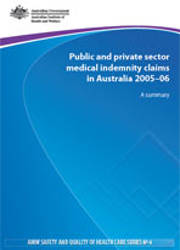Summary
This is the second report to contain data from the Medical Indemnity National Collection (MINC) on public and private sector medical indemnity claims. The purpose of the MINC, and this report, is to provide a national information base to assist policy makers to recognise trends in the nature, incidence and financial cost of medical indemnity claims and to provide an evidence base from which policy makers can develop and monitor measures to minimise the incidence of medical indemnity claims and the associated costs.
The data in this report cover claims current at any time during the reporting period 1 July 2005 to 30 June 2006; that is, claims that were open at the start of the period, new claims that arose during the period and claims finalised during the period. There is information on the circumstances giving rise to claims, the age and sex of people who allegedly suffered harm, the medical specialties involved in claims, the nature of injury, and the size, financial outcome and length of time claims have been open.
A claim is finalised when the claim is settled, a final court decision is made or the claim is withdrawn. 'Total claim size' is the amount agreed to be paid to the claimant in total settlement, including any interim payments, claimant legal costs and defence costs. Most claims were settled for less than $10,000 (42.7%), with 67% being settled for less than $100,000. No payment was made, or costs incurred, in 19.2% of finalised claims. Claims with sizes in excess of $500,000 constituted 2.8% of all finalised claims. The pattern of total claim size has changed since the 2004–05 reporting period. The proportion of claims settled for less than $100,000 decreased from 77.1% to 67% and the proportion of claims where no payment was made increased from 12.7% to 19.2% between 2004–05 and 2005–06 (AIHW 2007a). The most common incident/allegation type leading to a new claim against a clinician in 2005–06 related to 'procedure' (33.9%), followed by 'diagnosis' (21.4%) and 'treatment' (11.2%).
Neuromusculo-skeletal and movement–related functions and structures, for example loss of function due to inappropriate casting of a joint or restricted blood flow causing nerve damage, were the most commonly recorded primary body function/structure affected as a result of the alleged harm for new claims (17.7%). The next most common category for new claims was Functions / structures of the digestive, metabolic and endocrine systems, for example injury to gall bladder, bowel or pancreas, (15.8%), followed by genitourinary and reproductive functions and structures, for example injury to the reproductive organs, kidney, ureters or bladder (10.5%). Babies under 1 year of age were the subject of 5.5% of new claims; 4.7% of new claims related to children aged 1 to 18 years; and 62% involved adults aged over 18. For 27.8% of new claims the age of the claimant was not available.
Due to incomplete coverage of claims databases in some jurisdictions, data for approximately 89% of all public sector claims in scope are included. The private sector has reported 100% of claims in scope for this report.



